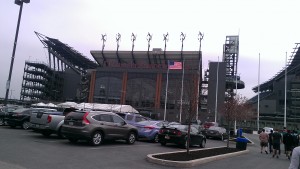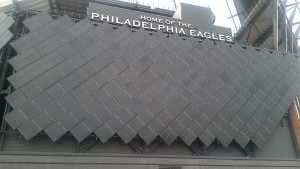Large sports arenas are perhaps one of the most inefficient land uses out there. Large buildings, used for a handful of days a year, with oversized parking lots and traffic nightmares for the community. Since my days taking classes with David Harvey at Johns Hopkins — when we spoke about all the problems with the (then) newly opened Oriole Park at Camden Yards — I have been critical of this wave of publicly funded stadium construction.
 So I was a bit skeptical back in late 2010 when the Philadelphia Eagles were trying to be the first net-zero energy stadium. Then, when the deal with SolarBlue fell through, I wasn’t surprised. But last spring, the Eagles once again announced a plan to install solar and wind facilities at Lincoln Financial Field — this time with Princeton-based NRG. And this time things are moving forward.
So I was a bit skeptical back in late 2010 when the Philadelphia Eagles were trying to be the first net-zero energy stadium. Then, when the deal with SolarBlue fell through, I wasn’t surprised. But last spring, the Eagles once again announced a plan to install solar and wind facilities at Lincoln Financial Field — this time with Princeton-based NRG. And this time things are moving forward.
 I had a chance today to take a tour of the stadium, as part of the Campus Sustainability Week activities here at Temple. And I have to admit that I was impressed. A few details:
I had a chance today to take a tour of the stadium, as part of the Campus Sustainability Week activities here at Temple. And I have to admit that I was impressed. A few details:
- Everything used in the stadium — all the way down to the beverage cups, hot dog wrappers, and beer cans (no more plastic) is either recyclable or compostable. Both are taken to off-site facilities for reprocessing.
- The team makes green sourcing (paint, carpets, etc.) a condition of any RFP they issue.
- And for what the team can’t control (tailgate trash), waste is separated and brought to a nearby cogeneration facility.
The result: 99.89% of waste is diverted from landfill.
Now, all of this isn’t going to make me an Eagles fan, but I have to say I’m very impressed by their result at Going Green.